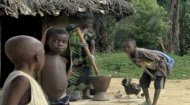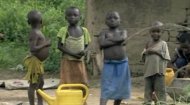Over half of the population of the Democratic Republic of Congo live in rural areas, typicaly in scattered villages ranging in size from 10 to 25 homes up to 150 to 200. Many of these inhabit the savanna woodlands of the south-central regions. Most rural housing units are tradtionally made from bamboo, straw and mud (above) while those in more urban areas are made from more durable materials and contain more rooms. Most households comprise an average of 5.3 members with around a quarter of them headed by women with most families in western areas of the country tending to be matrilineal, with the mother's brother as the male with the greatest authority in the family, rather than the husband although in other areas of the country, patriarchal and polygamous families, as well as combinations of these, are common.

The agricultural sector in the Democratic Republic of Congo (mainly growing cassava, yams, plantains, rice, and maize with cash crops including coffee, palm oil, rubber, cotton, sugar, tea, and cocoa), provides the livelihood for over 60% of the population and generates 19.7% of the country's GDP yet, despite having 80 million hectares of arable land, of which 4 million hectares are irrigated, together with many rivers providing rich fish resources, the country cannot ensure food security with nearly 900,000 children under the age of five and more than 400,000 pregnant or lactating women being acutely malnourished. Most families live on cassava, rice, potatoes, bananas, yams, beans, maize, fish, groundnuts, and various other fruits and vegetables with a staple food being fufu, a paste made from flour and water served with a sauce made from tomatoes or peanuts. Another popular food is shikwanga and meals are traditionally prepared using an outdoor wood or charcoal fire. Most rural families eat with their hands with men and the women and children often eating separately. For more about life in the Democratic Republic of Congo, check out the articles above.
|











